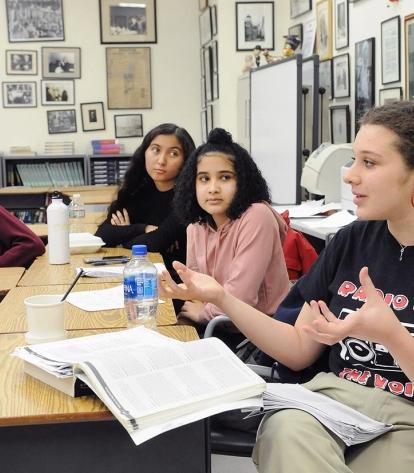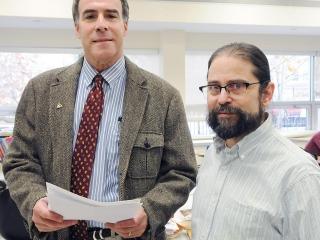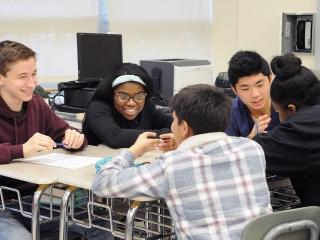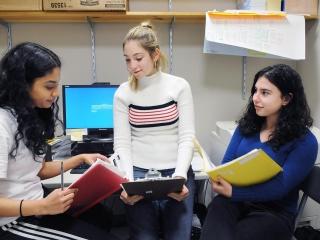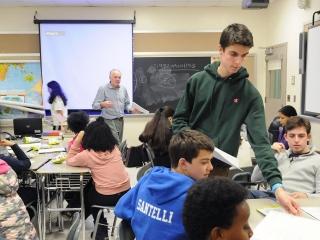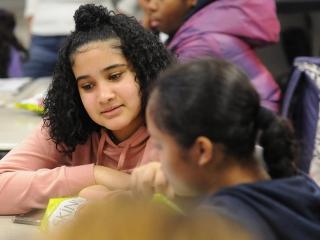While the debate rages across the city about whether scoring high on a single test is the fairest way to win a coveted seat in one of the city’s specialized high schools, students at the HS for American Studies at Lehman College are tutoring local middle school students to prepare them to meet the test challenge and ensure more diversity at the specialized school in the Bedford Park section of the Bronx.
“We know what it takes to get in here. Most of us had the advantage of test prep classes,” Julian Novarr, a junior who is one of the 20 tutors in the Local Outreach and Tutoring Program, pointed out. “Now, I’m giving back.”
The predominantly white and Asian high school is located in an overwhelmingly minority, low-income area where parents cannot afford test prep. Twice a week for two hours after school, 25 7th-graders from six neighboring middle schools arrive for tutoring in English and math. Under the watchful eye of history teacher Arnie Mansdorf, the tutors meet during lunch periods to prepare their lesson plans, pick materials, discuss how to phrase questions and handle homework for the tutorials.
“This is a crash course on how tough teaching is and how much planning goes into every lesson,” tutor Lillie Steen acknowledged during a planning session. “We go slow at the beginning of the year until we know what they know. We don’t want to scare them off.”
The problem with relying solely on the Specialized High School Admissions Test, Mansdorf noted, “is not that middle schools are not doing the job but that the test itself is not based on middle school curriculum.”
Habiba Sayma, one of the few tutors who did not have the test prep advantage but was valedictorian of her middle school, agreed that the admissions test “does not test general knowledge of school curriculum.”
“I’m really passionate about this program,” she said. “We had a debate about this issue in English class.”
Chapter Leader Jonathan Halabi, who founded the program in September 2017 with Mansdorf, scoured the middle schools, talking to principals, school counselors and teachers, and even brought the student teachers with him to encourage the middle schoolers to sign up.
“The ultimate goal of the program is to prepare the students to take the test,” junior Isabel Podolsky explained, “but we also want to give them an enriching after-school experience.”
The program starts with a snack and a whole-group activity for 30 minutes. This day, as students munched popcorn, English teacher Denis Murphy presented a brief lesson on the Gaelic language, or, as he put it with a whisper of brogue, “the language of Ireland.”
Pointing to a chart of everyday Gaelic phrases, he called on the tutors first to try their hand at pronouncing the difficult language. Their comic mispronunciations put the middle schoolers at ease and made it clear that making mistakes is OK, that they are a part of the learning process. The activity’s grand finale was a rousing sing-a-long in Gaelic about a mad puck goat.
Then it was on to the hard stuff with half the students working on probability problems — such as when two dice are rolled, what is the probability that both numbers showing are 6s? — while others searched for the author’s purpose in a shared reading passage. “Let’s go back into the text and find where the right answer is hidden,” a tutor suggested.
The high school students work with the younger students one-on-one or in groups of two or three. There was a comfortable hum of activity as the middle school students reviewed their homework, showed their work, discussed their answers and asked questions.
After 45 minutes, the students switched to the other subject.
Halabi, a math teacher, emphasizes that the program is student-run, down to choosing or creating tutoring materials. “I simply edit their choices,” he said.
The HS for American Studies opened in 2002 on the edge of the Lehman College campus. Students have access to the college gym, cafeteria and library and can take classes at Lehman in their junior and senior years.
The students reflect the school’s focus on social studies, history and English in their commitment to citizenship and community.
“It’s good for young people to know we can achieve changes in our communities, that actual students’ lives are being changed by their actions,” Principal Alessandro Weiss said.
Jacob Santelli, one of the tutors, summed up the rewards for the high school students. “It’s a great feeling,” he said, “when you explain something and they light up with understanding.”
